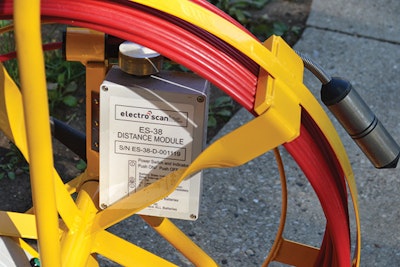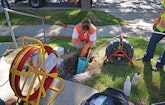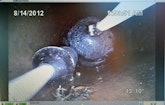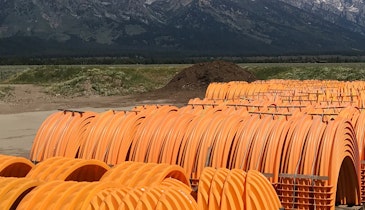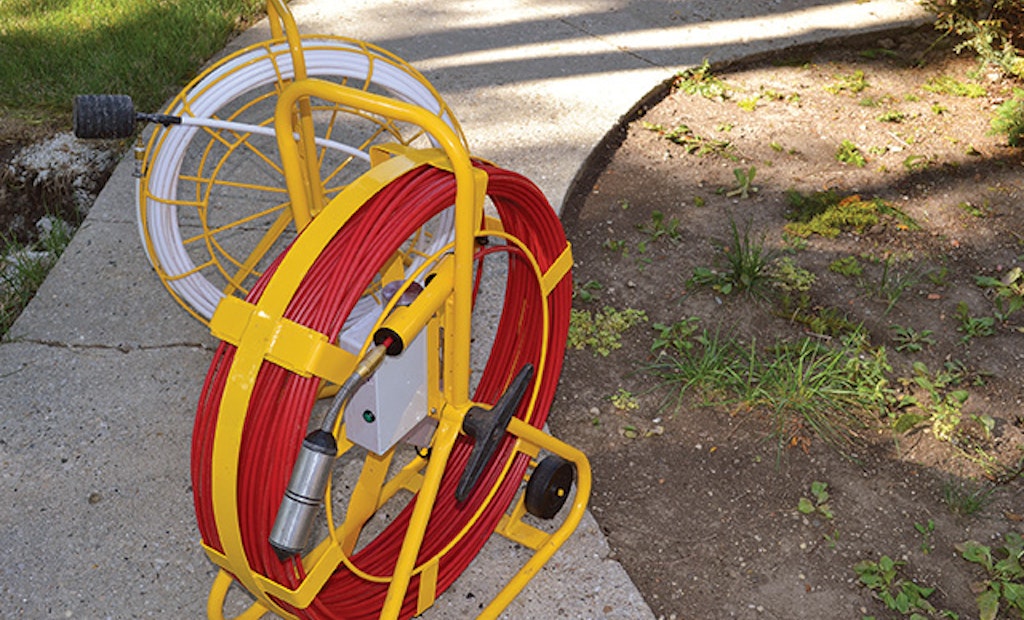
Interested in Rehab/Relining?
Get Rehab/Relining articles, news and videos right in your inbox! Sign up now.
Rehab/Relining + Get AlertsClosed-circuit television cameras and smoke and dye testing have been used to detect sewer leaks for years, but new technology is making its way into the field.
Electro Scan Inc., based in Sacramento, Calif., has introduced the Electro Scan ES-38 system, which uses low-level electrical current to pinpoint leaks. The Electro Scan system is controlled by and transmits data to smartphones and tablets, making use of various features on those devices.
The ES-38 system is designed and configured for use in 3- to 8-inch sewer laterals serving individual homes or businesses. It is the first in what the manufacturer expects to be a growing number of products and configurations employing this technology.
Mark Grabowski of Electro Scan demonstrated the product's features and abilities during a sewer lateral inspection project in a residential neighborhood of Wauwatosa, Wis., a suburb of Milwaukee, on Aug. 14, 2012. Grabowski was working with the municipality and Elizabeth Gruell of the engineering firm Brown and Caldwell in Milwaukee.
Walk-around
The heart of the ES-38 system is a probe 1.5 inches in diameter and 6.5 inches long. The probe consists of three electrodes. The 1/2-centimeter-thick center electrode sends out electric current that emanates from the probe in a circular, highly focused band. The larger front and rear electrodes focus the electrical stream.
The probe is attached to a reel-mounted cable. The line to be inspected is flooded with water, and the probe sent through to the far end. As the probe is pulled back to the entry point, it measures the resistance to the electric current it sends out. High and generally constant resistance indicates that the pipe is intact. Sharp drops in resistance indicate the presence of a leak.
"Pipe walls have a high resistance; where they're leaking has low resistance," Grabowski explained. "The electricity that flows out with the leaking water into the ground completes an electric circuit. Those instances are graphed to create a profile of a pipe's leaks. Using water also allows for an effective simulation of a pipe's performance during a wet-weather event, such as a rainstorm."
Data from the probe is collected on a tablet or smartphone equipped with Electro Scan's system operating software. The probe transmits its readings to the device wirelessly via Bluetooth connection, eliminating the need for transmission cables or a slip-ring on the reel.
Data is transmitted to Electro Scan's Internet-based cloud through a WiFi or 3G or 4G cellphone data connection. There, software automatically runs the raw data through a series of calculations to generate objective, quantitative data about leak locations and magnitude that is comprehensible to the user.
Grabowski says the system offers highly precise information, both for the location and magnitude of a leak, including calculations of estimated infiltration rates in gallons per minute (gpm).
Users view reports of their inspections with the device by logging on to CriticalSewers.com, where customer firms or municipalities each have unique portals giving them access to their data.
The ES-38 system includes 200 feet of cable mounted on a reel that also contains a battery case equipped with a control switch. The case holds the eight AA batteries that power the probe, which plugs into the cable.
The system is used with inflatable rubber pipe plugs that block the pipe so it can be flooded with water.
Operation
The City of Wauwatosa is in the process of inspecting sewer laterals for leaks that enable the inflow and infiltration of stormwater. Television inspections of the laterals had already been completed.
Grabowski explained that, some years ago, the city lowered the sewer main in the street and made new connections between the existing clay sewer laterals and the new main. The new connecting pipes are PVC and run at a sharp downward angle between the old laterals and the new main. It is assumed that the new connecting lines are unlikely to have developed leaks, so inspections have focused on the older clay laterals.
Although the laterals date to the 1940s and prior, each one has recently had a new clean-out installed as part of another city project. The clean-outs are generally in the front yard of each residence.
The ES-38 leak inspection process began with the insertion of inflatable rubber pipe plugs into the laterals: the first, just upstream from the clean-out toward the house, and the second downstream to the point where the downward-connecting pipe began.
After the upstream plug was secured, the downstream plug was inserted at the end of a 100-foot rigid hose. Once it reached what appeared to be — based on distance and the feel in the pipe — the downward junction, Gruell and Grabowski used a small push camera to view the plug and confirm its location at the downward bend. The plug was deflated slightly so it could be easily pulled back about two feet from the bend, and was then fully inflated to block the flow.
Grabowski calibrated the probe, touching an electrical lead from the probe's cable reel to the electrodes on the probe in a designated sequence. He used the Electro Scan software on his smartphone to complete the calibration.
He then took a metal screwdriver that was attached with a wire lead to the cable reel and stuck the blade into the ground up to the handle. He also poured a small amount of a saturated salt solution around it to ensure maximum conductivity. Grounding the circuit ensures that when the probe sends electricity out to the pipe — or through leaks in the pipe — it will have a complete circuit to enable measurement of the changes in the electrical resistance.
Grabowski explained that the system runs with 10 volts AC and at 40 milliamps — a very low level of electric current. "If you have your hand in the water as it goes by, you'll feel a slight tingle, but nothing more," he said.
At this point, the probe was ready for use. Grabowski entered the details of the inspection — the address, the lateral pipe material, the municipality and other information — into a header form using the Electro Scan app on his smartphone. At the entrance to the clean-out, he zeroed the distance on the app's inspection records.
Then, Gruell sent the probe into the lateral all the way to the downstream inflatable pipe block. Viewing the image from the push camera on a laptop computer, she could easily confirm that the probe had indeed reached the pipe block before removing the camera.
Grabowski noted that the camera itself is not an essential part of the process, but was simply employed by Brown and Caldwell as part of the engineering firm's study of the system, and because of the unusual configuration of the lateral/sewer main connections.
"Typically we don't use the camera," he said. "We just push it in until we feel it stop, then verify that the distance read [on the control app] matches up with the other data we have."
With the camera free and the probe still at the far end, water was pumped from a combination truck into the lateral.
Once the lateral was full up to the clean-out, the hose was shut off. Brown and Caldwell also wanted to measure the rate of exfiltration from the laterals, so Gruell stood a measuring stick up in the clean-out to measure how fast water was leaking from the lateral. Because water was descending fairly rapidly, more water was pumped in to fill the lateral again, and the hose was allowed to run continuously to make sure that the lateral stayed filled.
When Gruell was ready to reel the probe back from the far end of its transit, Grabowski used the tablet controls to start recording the findings. The probe data is recorded on pull-back rather than on push-in because it's likely to be more accurate and easier to pace steadily.
"Our ideal rate is around 30 feet per minute," says Grabowski.
Gruell then reeled the probe back from the opposite end at a steady pace. As she did so, Grabowski followed the progress by looking at the image on the tablet computer depicting long stretches of high resistance (intact pipe) and brief, high spikes depicting low resistance (leaks, or at least seams, in the pipe). The entire inspection run on the lateral — less than 200 feet — took less than 10 minutes.
Grabowski explained that the data on the tablet was still raw and, while it made for a dramatic image, still required uploading and detailed interpretation with the Electro Scan software.
Observer's comments
The Electro Scan device appears notable for its small size and professed ability to be precise.
The fact that data and images it records cannot be interpreted directly on site offers both advantages and disadvantages. The user cannot immediately interpret the data on the tablet screen; instead, it is processed immediately in the Electro Scan cloud.
As Grabowski pointed out, however, within a minute of the scan being uploaded in the field, an engineer back at the office can see and begin analyzing it.
Additionally, the operator can focus completely on the process of collecting data without being responsible for interpreting it on the fly; instead, while the operator collects the data, the engineer can analyze it as the situation dictates.
Brown and Caldwell took scans of more than 100 Wauwatosa laterals using the equipment and planned to compare the information collected from the ES-38 system with CCTV inspection records and other sources of information on leaks in the area inspected. That research was still under way at press time, but if the ES-38 proves to be reliable for finding major sources of lateral infiltration, "I think we would consider using it again," said Andy Lukas, a Brown and Caldwell vice president and the engineering firm's wet weather solutions leader.
The city's recent installation of clean-outs on the laterals outside homes — which was done to make a cured-in-place lateral lining project easier — made the use of the ES-38 much easier. Testing from basement clean-outs "would have brought a number of challenges, such as how to fill the laterals with water for the Electro Scan without overfilling it and flooding part of the basement," Lukas said.
Among the things the firm hopes to learn as it studies the system is whether it's best used just to find leaky laterals, or whether it can guide decisions regarding how much of a lateral to replace or repair.
Lukas said Electro Scan was responsive to its needs when difficulties arose uploading data to the cloud and making it available for viewing. "It seemed like Electro Scan was working hard to address the issues we brought to them in a timely manner."
Manufacturer's comments
The ES-38 is the first in Electro Scan's product line to reach the market. A similar system for mainline sewers 6 to 21 inches in diameter uses a probe 32 inches long and 3 inches in diameter, Grabowski said.
That device, the ES-620, is designed to use CCTV lines to power it instead of coming with its own cable, he noted, and thus could be easily integrated with a municipality's or business's CCTV truck. The unit was unveiled at WEFTEC at the end of September. The ES-620 uses a sliding funnel plug attached to a jetter hose that provides a constant — but moving — column of water in the pipe, rather than flooding the entire mainline pipe, Grabowski said.
While using conventional AA batteries might seem unusual as more and more devices are using rechargeables, Grabowski noted that the simpler batteries are going to be much easier to replace in the field, and that rechargeable battery systems sometimes pose problems if users aren't recharging properly.
A fresh set of 8 AA batteries can usually power up to 40 scans with the device — enough to last two or three days. The devise also signals when battery power is getting low, speeding up the normal every-two-minute beeping that the system makes when it is powered on.
Grabowski also noted that, with smartphones and tablets equipped with GPS positioning software, GPS data can be recorded for each inspection to keep a precise record of its location.
